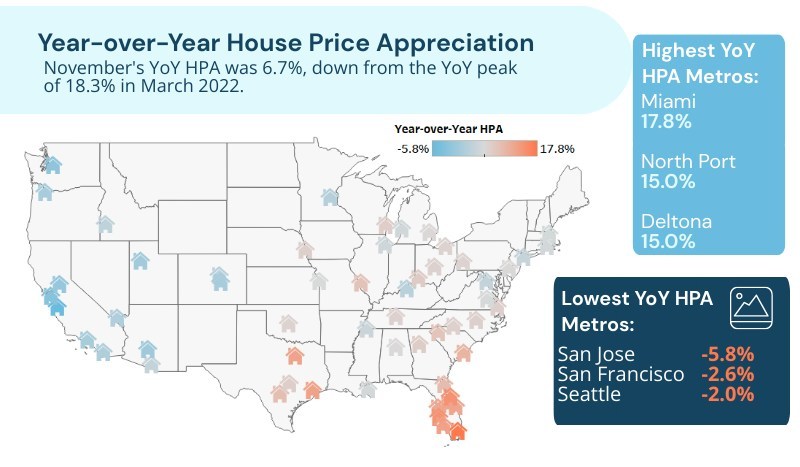According to new data from the American Enterprise Institute's (AEI) Housing Center, the nation's longest home price boom has ended after 10½ years. Nationally, prices have declined 3.1% from the peak in June. While all 60 largest metros have begun experiencing year-on-year price declines, San Jose, Seattle, and San Francisco have led the way with declines of 15.5%, 13.4%, and 12.7% from their peaks.
November's year-over-year Home Price Appreciation Index (HPA) was 6.7%, down from 8.5% a month ago, a year-over-year peak of 18.3% in March 2022 and 16.7% a year ago. Based on Optimal Blue rate lock data, year-over-year HPA is projected to decline further to 5% in December 2022 and 3% in January.
“The year-over-year decline in HPA continued in November with a rate of 6.7%, down from March 2022’s record pace of 18.3%," said Senior Fellow and Director of AEI Housing Center Ed Pinto. "All of the 10 fastest HPA metros were in the South (7 in Florida), and all of the 10 slowest HPA metros were in the West (San Jose, San Francisco, Seattle, Sacramento, Phoenix, Salt Lake City, Colorado Springs, Portland, Los Angeles, San
Diego)."

Year-over-year the HPA varied significantly among the 60 largest metros. It ranged from 2.6% and 5.8% in San Francisco and San Jose to 17.8% and 15.0% in Miami and North Port.
“Home prices in November increased a stunning 13.3% in Cape Coral, but it may continue as a leader due to a massive supply-demand imbalance, at least over the near term," said Research Fellow and Assistant Director of AEI Housing Center Tobias Peter. "Cape Coral is still relatively affordable compared to many other Florida and California markets. At the other end of the spectrum, San Francisco and San Jose have had the most dramatic slowdown and are among the first to show year-over-year declines.”
Historically, HPA in the low price tier outpaced HPA in the upper price tiers. This trend continues to hold true. Although home prices were down across all four price tiers, the high end and low end of the market were hit differently. In November, high price tier was down 4.6% from its peak in May 2022, while low price tier was down 3.1% from its peak in July.
November's months' supply & active listings both increased above seasonal trends, but remain at historically low levels. Months' supply stood at 2.5 months in November 2022, down from 3.0 months in November 2019, but up from 2.1 months in October 2022, and 0.9 months in May 2022. The months' supply for the high price tier came in at 6.2 months in November 2022, helping the price weakness for this tier.
The national month-over-month HPA in November was -0.9%, and it is expected to keep declining in December and January based on the Optimal Blue data. Regardless of seasonality, home prices seem to have peaked in all largest 60 metros. Year-over-year HPA is expected to slow to 5% and 3% for Dec. 2022 and Jan. 2023.
To read the full report, including more data, charts and methodology, click here.

 theMReport.com Your trusted source for mortgage banking news
theMReport.com Your trusted source for mortgage banking news








